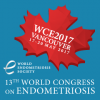World Congress on Endometriosis empowers women through advocacy and education
by Heather Guidone
The 13th World Congress on Endometriosis kicked off in Vancouver, Canada on 17 May 2017 with the overarching theme of “turning over a new leaf.” Over 440 abstracts were presented from 60 countries, representing the forefront of clinical and bench investigations being carried out around the world.
 The World Congresses have a rich history of bringing together all stakeholders in the disease, with the latest on evidence-based standards, education, research, and clinical care at the centre.
The World Congresses have a rich history of bringing together all stakeholders in the disease, with the latest on evidence-based standards, education, research, and clinical care at the centre.
WCE2017 once again brought together global partners to exchange ideas, innovations, and inspiration on topics ranging from pathogenesis, genetics/epigenetics, precision medicine, and co-morbidities to diagnosis, reproductive outcomes, and pain physiology, with a major focus on improving the well-being of individuals with endometriosis.
Empowering patients and the role of allied health care
“Empowering Patients and the Role of Allied Health Care” was a dedicated pre-congress course held to review basic science, surgery, medical treatments, and complementary therapies that may improve the quality of life of those with endometriosis.
Chaired by nurse Vibeke Amelung (DK) and clinician Paul Yong (CA), the session focused on the importance of collaborative efforts, self-care, and an integrative approach to the systemic effects of the disease.

Dr Paul Yong presenting at WCE2017
Launching the course was an overview of endometriosis including diagnosis, treatments, epidemiology, comorbidities, and overall burden. Presented by co-chair Paul Yong, much of the discussion centred on endometriosis-associated pain, which results from actual tissue impact as well as effects of the disease on the central nervous system. The resulting dysfunction can lead to amplification, distortion, and an increase in the degree of pain, often causing symptoms even in those who have had the disease surgically removed.
Changing the brain and changing pain
“Changing the Brain and Changing Pain,” presented by Karina Hansen (DK), challenged the common mindset that one ‘has to simply learn to live with pain.’ Psychosocial factors, neurochemical and structural changes, social contexts, prior treatment history, comorbidities, emotions, and realistic expectations have all been demonstrated to play a role in patient outcomes.

Dr Karina Ejgaard Hansen and nurse Vibeke Amelung at WCE2017
However, through a combined, personalised, approach and a strong patient-practitioner partnership, it is possible to manage and, in many cases, even reduce pain. By setting forth realistic treatment goals and expectations, adopting complementary therapies like acupuncture or Traditional Chinese Medicine, undergoing pelvic floor therapy following quality surgery, exercising, and implementing a healthy nutritional approach, and building a strong support system can all target pelvic pain by altering the way the brain processes painful stimulus.
Rather than ‘learning to live with it,’ data indicates that persistent pain may, in fact, be changeable through a dynamic approach that addresses the bio-psychosocial components of endometriosis in a multidisciplinary setting.
Complementary and alternative approaches to endometriosis
Continuing the theme, “Complementary and Alternative Approaches to Endometriosis” offered additional insight to changing pain through natural solutions.
Presenter Spence Pentland (CA) offered a stepwise approach towards increasing well-being and reducing the physical and emotional effects of endometriosis, such as setting health goals, implementing acupuncture, using Chinese herbs, naturopathy, and food as medicine, reducing toxins, and partnering with collaborative specialists for best care.
Why tuning in trumps turning out: mindfulness and endometriosis
In contrast to the “you’re just going to have to live it” mindset that many individuals with endometriosis encounter at some point in their journey, the importance of ‘mindfulness’ for coping, decreasing symptoms, and controlling pain was reviewed by Lori Brotto (CA) in her lecture, “Why Tuning in Trumps Turning Out: Mindfulness and Endometriosis.”
 Mindfulness, sometimes called relaxed wakefulness, is a practice rooted in Buddhist meditation which has been found to be an effective component of multidisciplinary treatment for various conditions.
Mindfulness, sometimes called relaxed wakefulness, is a practice rooted in Buddhist meditation which has been found to be an effective component of multidisciplinary treatment for various conditions.
Over the years, mindfulness has evolved into a structured programme, now used in many hospital and healthcare settings. Controlled trials have shown it can be extremely effective at improving pain. While an initial session may be conducted in the clinical setting, mindfulness can be practiced anywhere, at any time.
Exercise, function, and physiotherapy
Susannah Britnell (CA) reviewed the importance of “Exercise, Function and Physiotherapy” as part of a robust multidisciplinary approach to reducing pain. Manual, individualised approaches like exercise and physical therapies can restore physical function, reduce inflammation and help.

Course participants mingling over lunch
Scheduling self-care and rest in combination with individualised therapies can help restore physical function impaired by disease and address the multifactorial components of endometriosis.
However, it is imperative to let pain ‘be your guide’ and work with a specialist towards an individual baseline and highly personalised approach.
Advocacy and championing the cause: together we go the distance
The day closed out with a terrific session by Endometriosis and Pelvic Pain Coach and Consultant, Deborah Bush, Co-founder and Chief Executive of Endometriosis New Zealand. “Advocacy and Championing the Cause: Together we go the Distance” was a lively, interactive segment emphasising the critical importance of using peer reviewed resources when communicating about the disease, remembering who a campaign is trying to reach and influence, who can help, and how to create urgency for the cause versus the personal story.

Deborah Bush invigorating the audience at WCE2017
Utilising evidence-based resources and programmes while working collaboratively in the sector will ensure that any campaign is – correctly – “all about the people.”
Leading by example, Deborah Bush convened an ad-hoc, “spur of the moment best ever hypothetical advocacy campaign” and put everyone in the room to work – researchers, disease advocates, bloggers, media, and individuals with the disease.
Her “Endometriosis WoiW CampaignTM” [‘what outcomes are important to women’] demonstrated in real time how like-minded individuals with a selfless, common, goal to champion the cause can truly lead to positive changes – when we all come together.
The session drove home the key importance of:
- integrating a collaborative approach to fully address all the enigmatic aspects of the disease
- how critical multidisciplinary treatment is, ranging from surgery and pain management to cognitive therapies and select medications.
Deborah’s exciting course unsurprisingly brought about abundant discussion and left attendees invigorated for the coming days of WCE2017.






